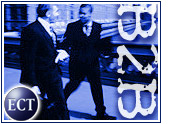
Overstock.com was preparing for its biggest sales day ever. It was just days before the notorious Black Friday, traditionally one of the busiest shopping days of the holiday season, and the discount online retailer was all set to break its previous year’s sales record.
And then it happened — its information technology infrastructure buckled under input/output overhead and Internet protocol issues.
As it turned out, Overstock’s infrastructure software wasn’t as scalable as the company thought it was. Database storage problems threatened to stall response times for millions of customers and potentially cost the company millions of dollars over the course of the weeks ahead.
“Information is the heart and soul of our business,” Shawn Schwegman, Overstock’s vice president of technology, said. “As a top-10 shopping Web site, we must be prepared to handle a surge in traffic during the holiday shopping season.”
Quick Access to Information
The online retailer implemented EMC Corporation’s information storage and management solution on an Oracle database run on clusters of Dell servers with Red Hat Linux. Now, Overstock can create online copies of production databases and refresh its reporting databases daily, among other operational tasks.
“Our IT infrastructure uses grid computing and powerhouse technologies of EMC and Oracle to ensure extraordinarily quick access to information,” Schwegman said. “Equally important, this advanced infrastructure allows us to get the most value from our IT investments and smoothly and reliably grow our storage with our expanding customer base.”
Like Overstock, online retailers learned plenty of lessons during — andafter — the 2004 online holiday shopping season. Now that all the sales data is in and the frenzy has fizzled, analysts said it’s time to reflect on the past few months in order to prepare for the months ahead.
Beginning with Infrastructure
Overstock learned that technology infrastructure is more critical than ever, and VeriSign Vice President of Payment Services Trevor Healy told the E-Commerce Times that other online retailers would do well to take a hint from Overstock’s experience before the same thing happens to them.
“People need to gear up for more volume. Infrastructure that handled the volume two or three years ago is now obsolete and needs to be upgraded,” Healy said. “There’s a year of foundation building that needs to happen because if this growth continues, we are going to be seeing online retail sales in the tens of billions next year.”
David Jilk, CEO of Xaffire, a Web application management software provider, agreed that infrastructure is an issue going forward. His firm partnered with Jupiter Research and Internet Retailer on a recent survey conducted with 220 online managers. The survey revealed that 51 percent learn about their sites’ Web errors from their shoppers, not the information technology staff.
“‘Click-and-mortar’ stores are really starting to understand that they must have a consistent and crisp user experience all the way through the site,” Jilk said. “It’s not just the credit card page that matters. It’s not just a store — it’s also a research tool.”
Multichannel Magic
Indeed, many online retailers are really multichannel retailers, withbrick-and-mortar stores in the real world. Craig Stevenson, worldwidemarketing manager for IBM Websphere Commerce, told the E-Commerce Times that multichannel retailers finally caught a glimpse of how much the Web influences offline sales during this past holiday shopping season.
“Retailers are beginning to realize that the Web is one of their bestmarketing tools and it’s at a much better cost than huge advertisements,” Stevenson said. “Retailers have to ensure that there’s consistency and a seamless experience for the customer between the different channels.”
Gartner analyst Adam Sarner told the E-Commerce Times that multichannel retailers learned that e-commerce doesn’t necessarily mean a transaction in an online shopping cart. “J. Crew knows that someone going to jcrew.com is 27 percent more likely to visit a J. Crew store soon afterwards,” Sarner said. “The Web is a powerful influence.”
Searching for Bargains
To that end, analysts said another e-lesson online retailers should takeaway from this past holiday shopping season is the importance of search — online retailers who are searching for profits should be searchable by shoppers.
A study by Web consultancy Link2City reveals that 33 percent of Internet users believe companies found in the top search results must be a major brand, demonstrating that top search engine listings transmit brand equity.
That makes the case for paid search. However, that’s not the only search case to be made. Natural search is also important, Stevenson said, if online retailers want the spiders to index their URLs so they appear in the search results of comparison shopping sites.
Comparison shopping sites came of age this past year. While approximately 54 million consumers visited one or more comparison shopping sites during the 2003 shopping season, according to Nielsen//NetRatings, that figure rose to more than 77 million during the same period in 2004.
“Once a consumer decides to search for a product or service on a comparison shopping site, they’re inclined to buy,” Purnendu Ojha, CEO and co-founder of NexTag told the E-Commerce Times. “At the point where a consumer conducts a search on a comparison shopping site and clicks through to an e-tailer whose listing they find appealing, that consumer is far more likely to make a purchase than a random site visitor.”
Bigger Picture
That, said Andy Beal , vice president of search marketing at searchoptimization firm WebSourced, leads us right back to multichannel retailing. Beal said that retailers’ view of the Web got much broader last year.
“In 2004, traditional retailers learned the Internet could drive in-storetraffic as much as generate online sales. Going forward, the Internet will play a crucial role within a retailer’s overall marketing mix,” Beal said.
He added: “In 2005, even brick-and-mortar stores will execute Internet campaigns to generate consumer interest and increase product recognition. Successful campaigns will drive in-store traffic as much as generate online sales.”
























































Social Media
See all Social Media